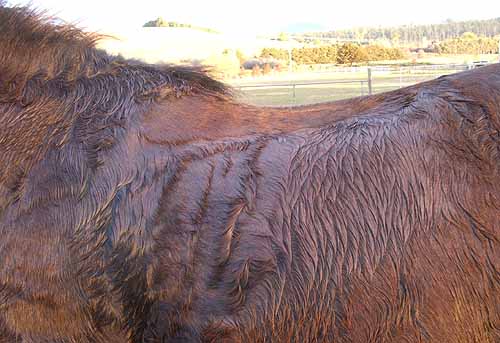Signs of a Bad Saddle Fit
Signs of a bad saddle fit
A good saddle fit will equal a safe, balanced, relaxing ride. Your horse will be well-behaved, stay healthy, and enjoy himself. Your riding skills will be enhanced and improved. You donít have to be an expert to tell if youíve got a bad saddle fit for you and your horse.
Most of the time, your own body or your horse will let you know loud and clear. If youíre pretty certain that you have a saddle with the correct gullet size for your horse, simply paying attention to how your horse acts and how your body feels will let you know if youíve got the right fit.
Signs of a Bad Saddle Fit for your Horse
Take a look at the saddle on the horse. You should be able to stick two of your fingers between the saddle gullet and your horseís withers. The saddle should have even contact along both sides of the bars. After girthing up, your saddle should look even on the horseís back, not tipping up or drooping down.
For a more specific description of the relationship between gullet width, bar angle, and how the tree should fit, visit our article here.

Another way to take a look at how the saddle fits your horse is to take him for a moderate ride, then unsaddle him and observe the sweat pattern. It should look like this horse's back. Everywhere you should have had contact between saddle and back should be sweaty.
There should be no odd dry spots, which would indicate that contact is not being made between the horse's back and the saddle. It could also indicate that too much pressure is building in one spot, not allowing the sweat glands to function.
If your horse is riding in a new saddle and starts acting bizarre, pay attention. Sometimes it is just a sign of the horse noticing and getting used to the new saddle, but it could also indicate a fitting problem. Some of the more common behavioral cues that something may be wrong are when your horse:
- Lays his ears back, swishes his tail, and tosses his head
- Walks off when you try to girth up or mount
- Bites the saddle
- Excessively stumbles or simply refuses to move
- Becomes sensitive to you touching his back
- Increasingly acts up the longer you ride
- Canít seem to relax under the saddle
- Slows down, bucks, runs away for no apparent reason
Tell-tale Sign of a Bad Fit
Saddle Sores
Caused by friction or pressure, saddles sores often stem from tack or saddles that are too tight or loose and begin to rub the horse. Sores can also be caused by a dirty horse, tack or unbalance riding.Dry Spots
After a ride, the horse's back should be evenly damp, except the spine. Dry spots indicate too much pressure in one spot. Untreated, these spots turn into white hairs.Temporary Swelling
Your horse's back has too much pressure on it, which causes a restriction in blood flow and leads to swelling.White Hairs
White hairs are caused by too much pressure on the same spot. The pressure stops blood flow, killing the sweat glands resulting in white hair.Muscle Atrophy
The saddle is probably pinching the horse, not allowing the muscles to work and develop while riding.Signs of a Bad Saddle Fit for You
On the other hand, a good saddle fit for your horse doesnít always equal the most comfortable ride for you. It should be noted that the more experienced you are at riding, the better a good saddle fit will feel. So if you are an inexperienced rider, you may need a veteran to check your saddle fit for you; your discomfort might have to do with your riding, not the saddle. However, the following are signs that the saddle youíre riding isnít a good fit for you:
- Feeling insecure in the saddle
- Feeling off balance or off center, like youíre going to fall out
- Difficulty keeping your alignment between hips and shoulders
- Knee pain